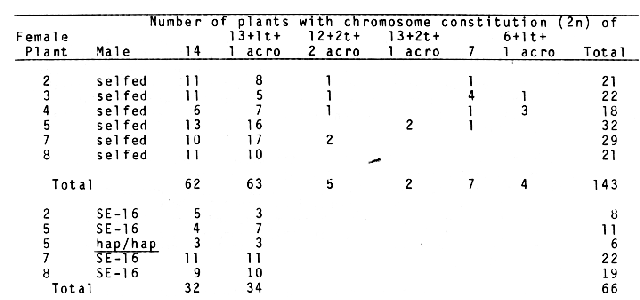

Department of Agronomy
Colorado State University
Fort Collins, Colorado, U.S.A.
1Supported by U.S.D.A. Competitive Research Grant No. 59-2081-1-1-691-0.
2Visiting Associate Professor, Leave of Absence from Gifu University, Gifu, Japan, July 1984, September 1985.
A plant with 2n=13+1 telocentric, 4SAL (inv) and I acrocentric chromosome, X4L4S (B) was found in the BC2 progeny of the cross between telotrisomic 4S.4L (inv) (formerly 4L (B)) and haploid inducer mutant (hap/hap). This plant, 13+1 telo 4SAL (inv) (B) + 1 acro 4L4S(B) pollinated by hap/hap again to produce seven BC3 progenies with 13+1 telocentric (1 telo) + 1 acrocentric (1 acro) chromosomes and one with 2n=14. A total of 209 offsprings from 6 plants with 2n= 13 + I telo + 1 acro were analyzed cytologically (Table 1). The cross with Shin Ebisu 16 (SE16) or hap/hap produced seeds with 2n=14 or 13 + 1 telo + I acro in equal number, indicating equal segregation and function between two types of gametes (n=7 and n=6 + I telo + I acro) in macrosporogenesis. This is not the case in selfed progenies: In the selfed progeny 62 plants with 2n=14 and 63 with 2n=13 + 1 telo + 1 acro were observed in a population of 143. Only five plants of 2n=12+2 telo + 2 acros were obtained. This indicates that the pollen carrying 6+1 telo + 1 acro fertilized seldom in selfed six BC3 plants, however.
Tsuchiya (1971, 1973 and unpublished) obtained genetically well balanced plants with 2n=13 + 2 telos for chromosomes 1. Singh and Tsuchiya (1981) reported on another compensating trisomic, 13+1 acro 3L3S + 1 telo 3S for chromosome 3. These authors observed that 2 kinds of pollen with n=6+2 telos (lL+lS) in chromosome 1 or n=6=1 acro + 1 telo in chromosome 3 can compete very well with normal pollen with n=7 in fertilization. No major differences in plant morphology and heading date among the plants of 2n=14, 13+2 telos (lL+lS) and 12+4 telos (a pair of 1L + a pair of IS) in the former, or 14, 13+ 1 acro 3L3S + 1 telo 3S, in the latter case.
The compensating trisomic and compensating tetrasomic in the present report differs in plant morphology from normal sibling plant (2n=14), however. Moreover, dosage effect was obseved between plants of 13+ 1 telo 4S.4L (inv.) B + I acro (4L(B)) and 12+2 telo 4S.4L (inv.)(B)) + 2 acros (4L4S(B)) indicating that considerable effect of proximal segment of the long arm of Chromosome 4 on morphological character or developmental aspect. Giemsa N-banding technique showed that this acrocentric chromosome carried deficiency of about two thirds of the distal segment of the short arm in chromosome 4. On the other hand, the telosome consists of complete short arm and pericentrically inverted segment of proximal heterochromatic region of the long arm of chromosome 4.

References:
Singh, R. J. 1981. A novel compensating partial tetracomic diploid of barley. BGN 11:66-68.
Tsuchiya, T. 1971. Occurrence of a plant with 2n=13+2 telocentric chromosomes in barley. BGN 1:63.
Tsuchiya, T. 1973. A barley strain with 2n=12+4 telocentric chromosomes (2 pairs). Cereal Res. Commun. 1: